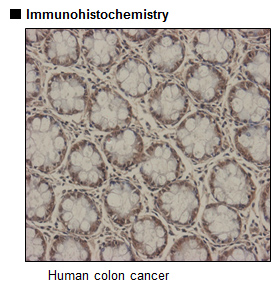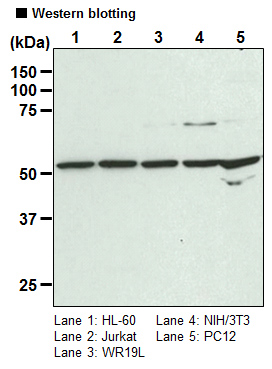Anti-rck (p54) pAb
| Code | Size | Price |
|---|
| MBL-PD009 | 100 ul | £334.00 |
Quantity:
Prices exclude any Taxes / VAT
Overview
Host Type: Rabbit
Antibody Isotype: IgG
Antibody Clonality: Polyclonal
Regulatory Status: RUO
Target Species:
- Human
- Mouse
- Rat
Applications:
- Immunocytochemistry (ICC)
- Immunohistochemistry (IHC)
- Western Blot (WB)
Shipping:
4°C
Storage:
-20°C
Images
Documents
Further Information
Applications:
WB - 1:1,000 (chemiluminescence detection system) ICC - reference 2), 6), 8), 9) and 11) IHC - 1:100
Background:
The lymphoma-associated rck (p54) gene product is a member of the DEAD box protein/RNA helicase family which has a variety of functions such as translation initiation, pre-mRNA splicing and ribosome assembly. Overexpression of human rck in a guinea pig cell line strongly inhibited the cell growth, and rck (p54) overexpression was found in >65% of colorectal tumours and >90% of hepatocellular carcinomas. Expression in tumors highly correlates with c-myc expression (>92%), suggesting rck (p54) may contribute to cell proliferation and carcinogenesis by increasing synthesis of c-myc protein via increased translation initiation of c-myc mRNA.
Formulation:
100 ul volume of PBS containing 50% glycerol, pH 7.2. No preservative is contained.
Gene IDs:
Human: 1656 Mouse: 13209 Rat: 500988
Immunogen Translated:
KLH-STARTENPVIC peptide synthesis
Reactivity:
This antibody reacts with rck (p54) (54 kDa) on Western blotting and Immunohistochemistry.
Shelf Life:
1 year
Source:
This antibody was purified from rabbit serum using affinity column. The rabbit was immunized with KLH conjugated synthetic peptide KLH- STARTENPVIC.
Target:
Rck/p54
References
1)
Yu, S. F., et al., PLoS Pathog. 7, e1002303 (2011)
2)
Melemedjian, O. K., et al., Mol. Pain 7, 70 (2011)
3)
Yao, B., et al., Nucleic Acid Res. 39, 2534-2547 (2011)
4)
Pauley, K. M., et al., Immunol. Cell Biol. 88, 205-212 (2010)
5)
Swetloff, A., et al., Mol. Cell Biol. 20, 4951-4961 (2009)
6)
Carlos, T. S., et al., J. Gen. Virol. 90, 2147-2156 (2009)
7)
Broytman, O., et al., Neurobiol. Aging 30, 1962-1974 (2009)
8)
Zeitelhofer, M., et al., J. Neurosci 28, 7555-7562 (2008)
9)
Lian, S., et al., Mol. Cell Biol. 18, 3375-3387 (2007)
This antibody is used in these references.




